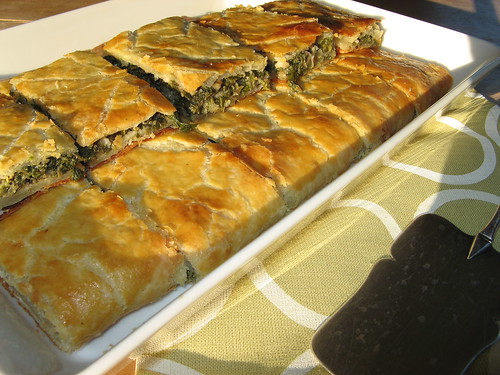
On a gorgeous Sunday in early May K. and I walked along the paths of my - sorry, our -
childhood summers. Literally. And during that walk, we packed a small linen bag with young ground elder leaves. You see, ever since buying the book on the culinary use of wild herbs & weeds few months ago, I've been discovering new edible wild plants galore. Eating
dandelion greens is almost conservative now. I've turned
dandelion blossoms into dark and sticky syrup, thrown
milk thistle leaves into my salads, and yes, eaten enough
wild garlic leaves to provide me with vitamins for months, and yes, even made a pie out of
ground-elder. I can see that not everybody gets excited about stuff like that - even my 87-year old grandmother was a bit suspicious of me collecting these weeds for human consumption. But luckily K. is very supportive, and doesn't mind being fed one 'interesting' dish after another.
 Ground-elder
Ground-elder (
Aegopodium podagraria, also known as bishop's weed and goutweed in English,
naat in Estonian) has a long history of being used for medicinal purposes, but it was also cultivated as a food crop in the Middle Ages, especially in
Russia (and in
Siberia in particular - the Russian
Saint Seraphim of Sarov is said to have survived three years on eating mainly ground-elder while on self-exposed exile in a deep forest),
Scandinavia, in
Central Europe. Old
Finno-Ugric peoples were keen consumers of ground elder, too. According to some sources, old traders wrapped their vegetables into ground elder leaves to keep them fresh looking and smelling - the leaves are
high in essential oils and helped to keep the other produce fresh and aromatic, too. Young and tender ground-elder leaves can be added to soups, omelettes and stews. Blanched leaves can be mixed with cottage cheese and curd cheese. The leaves are high on
Vitamin E, as well as
vitamin C, they're rich in
antioxidants,
minerals,
flavonoids and
fibre. Dishes containing ground elder are easily digestible, and have cleansing properties - so they're good for that spring-time detoxing :)
 A hortapita in Portaria, June 2006
A hortapita in Portaria, June 2006
I decided to make
hortapita with my ground elder leaves. The wise Greek village women, you see, have been using wild greens -
horta - for culinary purposes forever. I enjoyed
hortapita in a shady cafe in
Portaria (see the photo above) during my
2006 trip to Greece. Its slightly more elegant and modern version -
spanakopita - is one of my favourite pies. Using my ground elder bounty for a Greek hortapita seemed like the most logical thing to do. The Greek villagers would use lots of other wild and bitter leaves for making hortopita (and other dishes too, obviously, like salads etc).
Amaranth (
vlita in Greek, one of the most popular horta's -
rebashein),
sow thistle (
tsochos /
piimaohakas),
stinging nettles (
tsouknithes /
kõrvenõges),
mallow (
molocha /
kassinaeris),
dandelion,
purslane (
glistrida or
andrakles /
portulak),
wild carrots, as well as more familiar
chicory,
sorrel,
mustard greens,
rocket,
endives and others. Ground elder makes as good a pie filling as any of the others mentioned - just a little bit bitter, gutsy and earthy.
The
pastry recipe is from my friend Virve, who uses it to make a fabulously easy apple pie. It's the easiest pastry to work with and it tastes wonderful - it's easy, soft and pliable dough that procudes a flaky and wonderful pastry. The filling is inspired by my
spanakopita recipe.
Hortapita or a Greek-style pie with wild greens
(
Naadipirukas)
Serves 8

Pastry:
200 grams butter
200 grams sour cream
350 grams plain flour
a pinch of salt
Filling:
3 Tbsp oil
200 grams young ground-elder leaves
100 grams onion, finely chopped
200 grams cottage cheese or feta cheese
1 egg
1 Tbsp dried oregano
salt and coarsely ground black pepper
First, prepare the pastry. Melt the butter on a medium heat, take off the heat and cool a little. Mix in sour cream, flour and salt. Knead until the pastry comes together - it'll be very soft and pliable, like plastiline. Wrap into cling film and put into the fridge for up to 30 minutes (leave it for much longer, and you'll have hard time rolling it!)
Meanwhile, prepare the filling. Wash the wild greens, dry thoroughly. Heat a non-stick frying pan and 'cook' the leaves until they 'wilt'. Then quickly rinse them under cold running water to stop them from cooking further. Press until dry, and chop the cooked leaves coarsely.
Heat the non-stick frying pan again, this time with oil on it. Add the onion and cook on a low heat for about 10 minutes, until onion starts to soften. Take off the heat.
Now add the other ingredients, mix thoroughly.
Roll the relaxed dough to a large rectangle about 4-5 mm thick, cut into 2 more or less equally sized rectangles. Place the smaller one on a medium-sized oven tray, spread the filling on top, and cover with the larger dough sheet. Pinch the edges firmly together, pierce with a fork couple of times and brush with whisked egg.
Bake at 200C for 25-30 minutes, until golden brown. Cool a little and cut into squares.










































